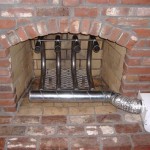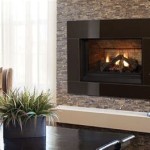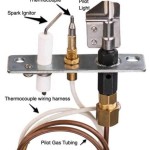Outdoor Fireplace Dimensions: A Comprehensive Guide
Outdoor fireplaces have become increasingly popular as homeowners seek to extend their living spaces and create inviting outdoor environments. These structures offer warmth, ambiance, and a focal point for gatherings, transforming patios, decks, and backyards into comfortable and aesthetically pleasing areas. However, before embarking on the construction or purchase of an outdoor fireplace, careful consideration must be given to its dimensions. The size and proportions of the fireplace will significantly impact its functionality, aesthetics, and overall integration with the surrounding landscape. This article provides a comprehensive guide to understanding the various aspects of outdoor fireplace dimensions, ensuring a well-planned and successful project.
Determining the appropriate dimensions for an outdoor fireplace involves a multifaceted approach, taking into account factors such as the intended use, the available space, the desired aesthetic, and relevant building codes and regulations. Neglecting any of these factors can result in a fireplace that is either disproportionate to its surroundings, inefficient in its heating performance, or in violation of local ordinances. Therefore, a thorough understanding of dimensional considerations is paramount.
Understanding Key Dimensional Components
An outdoor fireplace comprises several key dimensional components, each playing a critical role in its overall design and functionality. These components include the firebox, the chimney, the hearth, and the overall footprint of the structure.
The firebox is the heart of the fireplace, the chamber where the fire is contained. Its dimensions directly influence the size of the fire that can be built, the amount of heat it radiates, and the efficiency of combustion. Typical firebox dimensions range from 30 to 48 inches in width, 24 to 36 inches in depth, and 24 to 36 inches in height. Larger fireboxes are suitable for larger outdoor spaces and those who desire a more substantial fire, while smaller fireboxes are better suited for smaller areas and more intimate settings. The depth of the firebox is particularly important, as it determines how far the fire sits back from the opening, influencing the radiant heat experienced by those seated nearby.
The chimney, or flue, is responsible for venting the smoke and fumes produced by the fire. Its dimensions are critical for ensuring proper draft and preventing smoke from billowing back into the outdoor space. The height of the chimney is particularly important, as it must be sufficient to create adequate draft. A general rule of thumb is that the chimney should extend at least two feet above any part of the structure within ten feet of it. The diameter or cross-sectional area of the chimney should also be appropriately sized for the firebox. Undersized chimneys can lead to poor draft and smoke problems, while oversized chimneys can result in excessive heat loss. Professional chimney sweeps or fireplace installers can provide guidance on determining the optimal chimney dimensions for a specific fireplace design.
The hearth is the non-combustible area in front of the firebox opening. Its purpose is to protect the surrounding ground or flooring from sparks and embers. The size of the hearth is typically dictated by building codes, which specify minimum distances from the firebox opening. A common requirement is that the hearth should extend at least 16 inches in front of the firebox and 8 inches on either side. Larger hearths can provide additional safety and create a more visually appealing transition between the fireplace and the surrounding landscape. The hearth can be constructed from a variety of non-combustible materials, such as brick, stone, concrete, or tile.
The overall footprint of the fireplace refers to the total area it occupies. This is an important consideration, as it will impact the layout of the outdoor space and the availability of seating and other amenities. A large fireplace can dominate a small patio, while a small fireplace may seem insignificant in a large backyard. It is essential to carefully measure the available space and consider the desired proportions of the fireplace in relation to its surroundings. The footprint should also account for any clearances required by building codes or manufacturers' instructions.
Factors Influencing Fireplace Dimensions
Several factors influence the optimal dimensions for an outdoor fireplace. These factors relate to the intended use of the fireplace, the size and layout of the outdoor space, the desired aesthetic, and any applicable building codes and regulations.
The intended use of the fireplace is a primary determinant of its size. A fireplace intended primarily for ambiance and occasional use may require a smaller firebox and chimney than a fireplace intended for frequent use as a primary heat source. If the fireplace will be used for cooking, the firebox should be large enough to accommodate grilling or other cooking equipment. The size of the gatherings that will be held around the fireplace should also be considered. A larger gathering will necessitate a larger firebox and a more substantial overall structure to provide adequate warmth and visual impact.
The size and layout of the outdoor space are crucial considerations. A large backyard can easily accommodate a large, impressive fireplace, while a small patio may only be suitable for a smaller, more compact design. The layout of the space should also be taken into account. A fireplace placed in a corner may require different dimensions than one situated against a wall or in the center of the space. It is important to ensure that the fireplace does not obstruct walkways or interfere with other outdoor activities.
The desired aesthetic plays a significant role in determining the dimensions of the fireplace. A modern, minimalist design may call for a sleek, streamlined fireplace with clean lines and minimal ornamentation. A rustic, traditional design may incorporate a larger, more substantial structure with natural stone and a more prominent chimney. The dimensions of the fireplace should complement the overall style of the outdoor space and reflect the homeowner's personal preferences. Consideration should be given to the materials used in the construction of the fireplace, as different materials can influence the perceived size and scale of the structure.
Building codes and regulations are often the most stringent requirements influencing fireplace dimensions. Local codes may specify minimum distances from property lines, setbacks from structures, chimney height requirements, and hearth size requirements. It is essential to consult with local building officials or a qualified contractor to ensure that the fireplace design complies with all applicable codes. Failure to comply with building codes can result in costly delays and modifications.
Dimensional Considerations for Different Fireplace Types
The type of outdoor fireplace also influences the dimensional considerations. There are several different types of outdoor fireplaces, each with its own unique characteristics and requirements.
Prefabricated outdoor fireplaces are typically made of metal or concrete and are designed to be assembled on site. These fireplaces often come in standard sizes, with limited options for customization. The dimensions of prefabricated fireplaces are usually dictated by the manufacturer's specifications. It is important to carefully review these specifications to ensure that the fireplace is appropriate for the intended use and location. While prefabricated fireplaces offer convenience and ease of installation, their dimensional flexibility is often limited.
Custom-built outdoor fireplaces offer the greatest flexibility in terms of dimensions and design. These fireplaces are constructed from scratch using materials such as brick, stone, or concrete. The dimensions of a custom-built fireplace can be tailored to the specific needs and preferences of the homeowner. However, custom-built fireplaces require more planning and expertise than prefabricated models. It is essential to work with a qualified contractor or designer to ensure that the fireplace is properly designed and constructed.
Outdoor fireplace kits offer a compromise between prefabricated and custom-built options. These kits typically include pre-cut or pre-cast components that can be assembled on site. The dimensions of fireplace kits are usually somewhat flexible, allowing for some degree of customization. Fireplace kits can be a good option for homeowners who want a custom look without the complexity of a fully custom-built fireplace.
Regardless of the type of fireplace chosen, it is crucial to carefully consider the dimensions and ensure that they are appropriate for the intended use, the available space, the desired aesthetic, and any applicable building codes and regulations. A well-planned and properly sized outdoor fireplace will provide years of enjoyment and enhance the value of the home.

Fireplace Dimensions Outdoor Kitchen Design Rustic

Fireplace Dimensions Outdoor Brick

Outdoor Fireplace Installation Concord Ma Stoneworks

Barn Pros Closed Fireplace Dimensions Diy Outdoor Plans

Outdoor Fireplace Frame Dimension Form

Outdoor Fireplace Burntech Vista Oceanside Carlsbad Escondido Encinitas San Diego Area

Diy Outdoor Fireplace Kit Fremont Makes Hardscaping And Easy

Pin By David O Bryan On Patio Outdoor Kitchen Fireplace Dimensions Interior Design Plan Cabin

Grand Fireplace Kit Rochester Concrete S

Average Fire Pit Dimensions Sizes Landscaping Network
Related Posts








